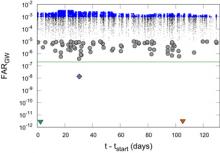
Abstract
We present a search for prompt gamma-ray counterparts to compact binary coalescence gravitational wave (GW) candidates from Advanced LIGO's first observing run (O1). As demonstrated by the multimessenger observations of GW170817/GRB 170817A, electromagnetic and GW observations provide complementary information about the astrophysical source, and in the case of weaker candidates, may strengthen the case for an astrophysical origin. Here we investigate low-significance GW candidates from the O1 compact binary coalescence searches using the Fermi Gamma-Ray Burst Monitor (GBM), leveraging its all sky and broad energy coverage. Candidates are ranked and compared to background to measure the significance. Those with false alarm rates (FARs) of less than 10−5 Hz (about one per day, yielding a total of 81 candidates) are used as the search sample for gamma-ray follow-up. No GW candidates were found to be coincident with gamma-ray transients independently identified by blind searches of the GBM data. In addition, GW candidate event times were followed up by a separate targeted search of GBM data. Among the resulting GBM events, the two with the lowest FARs were the gamma-ray transient GW150914-GBM presented in Connaughton et al. and a solar flare in chance coincidence with a GW candidate.